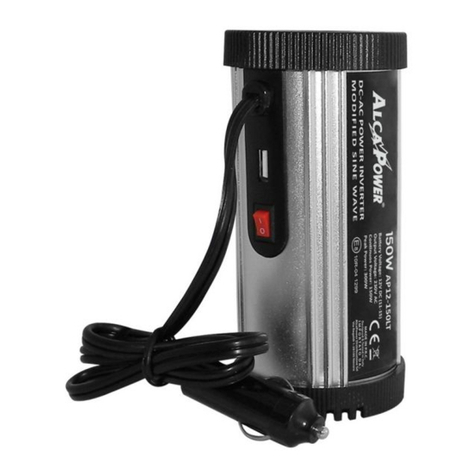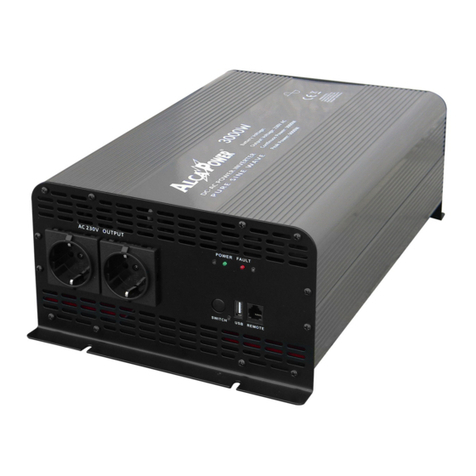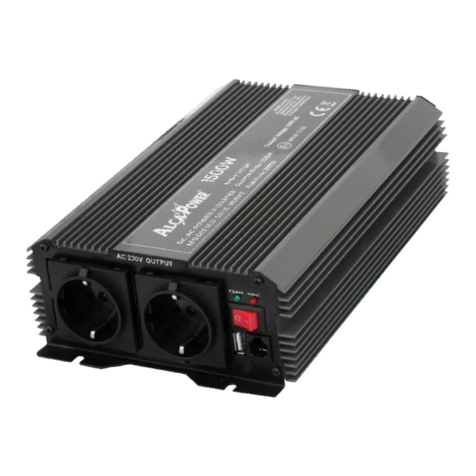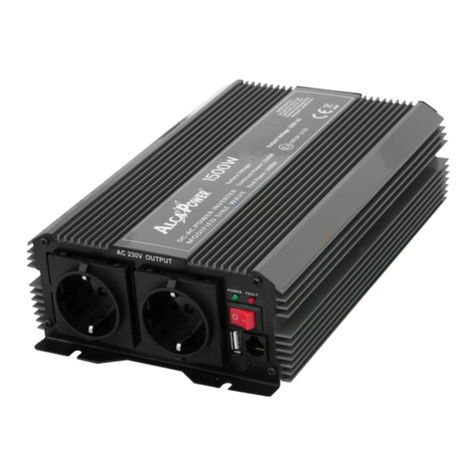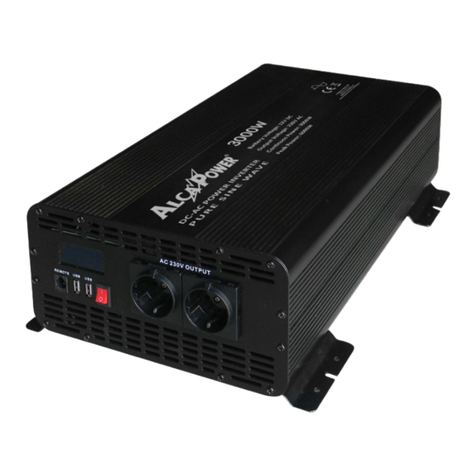
TECHNICAL CHARACTERISTICS
EN
Input voltage 10-15.5V DC
Output voltage 230V AC ± 10%, 50Hz ± 3Hz
USB output 5V DC, 2.1A max
Nominal power 1500W
Peak power 4500W
Output waveform Pure sine wave, THD is about ≤3%
Eciency ≥ 90%
No load current about ≤1A
Input low voltage alarm 10.5V DC ± 0.5V
Input low voltage shutdown 9.5V DC ± 0.5V
Input overvoltage shutdown 15.5V DC ± 0.5V
Operating temperature From -10°C to 50°C
Fuses 6 pcs of 30A
Cooling fans Fans star when the output load is greater than 10% of the nominal
power and the internal temperature reaches 55°C.
Dimensions 372x230x108mm
Protection grade IP20
Weight About 5.8Kg
(*) The USB port is only active when the inverter is on (ON / OFF switch set to ON).
FUSES REPLACEMENT
The power inverter is equipped with internal protection fuses. In case they burn, mainly due to reverse po-
larity connection between the inverter and the batteries, the fuses must be replaced with new ones having
the same capacity and dimensions. Usually, after replacing the fuses, the power inverter starts working
again. In cases where, after replacing the fuses, the inverter is still not working it is necessary to call for
assistance.
Note. Spare fuses are provided with the products.
Note. The power inverter must be disconnected both from the batteries and from any appliance during the
fuses replacement.
Note. After replacing the fuses, make sure that the input terminals are not short-circuited before recon-
necting and turning on the inverter. In case of short circuits you must call for the assistance.
Note. There are high temperatures and potentially lethal currents inside the power inverter, even after
disconnecting the inverter from the batteries. For this reason, the fuses replacement must be entrusted to
a professional technician.
13
AlcaPower - 912216 PS1550W-12 - User Manual R2 [09/23/2019] © All rights reserved
Note: all pictures shown in this manual are for illustration purpose only, are not contractual
and may dier from the actual product.
WARNINGS
Electricity is a source of danger.
Before using this product, make sure that the use of the same
complies with current legal provisions to safeguard your own
health and safety as well as that of others. Therefore, it is ne-
cessary to use the product in accordance with current regula-
ons, standards and provisions to safeguard your own health
and safety, by following the instrucons, fully complying with
the condions prescribed in this manual.
Untrained, unaware individuals and minors
It is strictly forbidden to allow children, individuals who have
not been appropriately informed and non self-sucient people
to use the product without the supervision of an adult who is
aware of how to properly use such equipment.
It is forbidden to use the product for any other purpose other
than that specied in the instrucons, or that may go beyond
its intended use that could prove to be a source of danger.
Foreseeable or unforeseeable misuse
Any use of this baery charger other than that specied in the
instrucons, or which goes beyond the designated use, is con-
sidered as non-compliant. Therefore, it is deemed as incom-
pable, improper, unforeseeable misuse and for such reasons,
this conduct brings about a high level of danger. Consequently,
with immediate eect, AlcaPower shall not be held responsi-
ble in any way whatsoever for damage caused by means of the
abovemenoned conduct.
Exempon from liability
Under no circumstances whatsoever shall AlcaPower Distribu-
zione Srl be held responsible in the following cases:
• If the product is not used properly.
• If the safety standards and regulaons are not complied
with.
• If improper and reasonably foreseen uses of the product
is not considered.
• If the assembly procedure and/or electrical connecon
are not carried out properly.
• If the correct operaon of the product is not regularly
inspected.
• If repairs and/or modicaons are made to the product
that alter its integrity.
Serious damage or injuries!
In the event of incorrect or inappropriate electrical con-
necons!
Electrical connecons must be carried out by paying parcular
aenon, in accordance with standards and regulaons to sa-
feguard your own health and safety.
Serious accidents in case of the selecon of fun-
cons and operaons!
• Despite the safety protecons present on the product,
check that operaons caused by the incorrect selecon of
funcons are not carried out.
• Select the funcons so that the safety protecons can act
in accordance with safety standards.
• Select the funcons as described in the instrucons.
• Any connecon to other equipment must be monitored to
guarantee the utmost level of safety.
An error may cause high risk situaons!
Before, during and aer use: cables, plugs and connectors must
be carefully checked to avoid a short circuit and to make sure
that they are intact and have no bare wires or parts that are
even parally damaged.
Pay aenon to the environment in which you are
working!
Hazardous situaons may be caused by the people, animals or
materials present in the surrounding environment in which you
are using the product. Humidity, gas, vapours, fumes, liquids,
noise, vibraons, high temperatures, possible falling of mate-
rials, and explosive atmospheres.
Inadvertent product start-up and/or interrupon!
Hazardous situaons may arise following inadvertent and sud-
den start-ups or interrupons of the operaonal funcons of
the product. Carry out inspecons and check prior to starng
up or interrupng the operaonal funcons of the product.
Abnormal operaonal funcons!
ln the event of abnormal operaonal funcons of the product,
it is necessary to promptly interrupt the operaon of the pro-
duct. See the instrucons in the product-specic user manual.
Warranty: this product is covered by a warranty under the
terms of the current applicable law. In case of need, contact
the sales outlet where you bought the product.
DECLARATION OF CONFORMITY (Extract)
AlcaPower Distribuzione Srl does hereby declare that the pro-
duct complies with essenal requirements set forth by current
legislaon.
EN
DISPOSAL. The crossed dustbin symbol reported on the product indicates that, at the end of its
useful life, the product must be collected separately from other waste. Therefore, the end-user must
deliver the product to the collecon centers for electric and electronic waste (WEEE). Alternavely, the
product can be returned to the retailer shop when buying a new product of the same type, in a rao
of one to one, or one to zero for products having external dimension no more than 25cm. A separate
collecon guarantees the recovery and reuse of the materials used in manufactoring the product, con-
tributes to the respect of the environment and the protecon of health by prevenng polluon and
reducing the need for raw materials.
14







